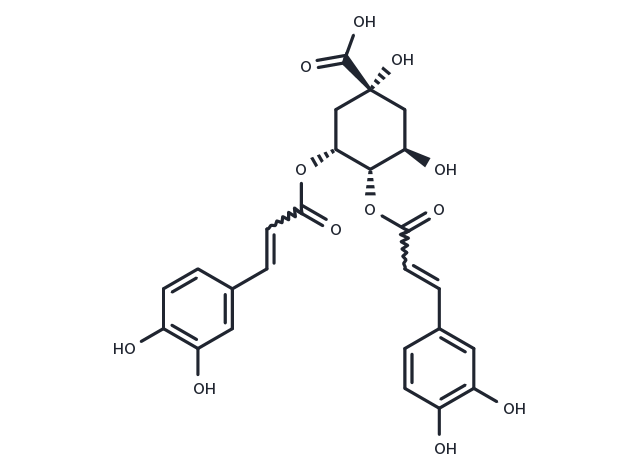Powder: -20°C for 3 years | In solvent: -80°C for 1 year


1. 4,5-Dicaffeoylquinic acid (Isochlorogenic acid C) has antiviral activity, including anti-HIV-1 integrase activity. 2. 4,5-Dicaffeoylquinic acid (Isochlorogenic acid C) shows anti-hepatotoxic activity.

| Pack Size | Availability | Price/USD | Quantity |
|---|---|---|---|
| 1 mg | In stock | $ 38.00 | |
| 5 mg | In stock | $ 81.00 | |
| 10 mg | In stock | $ 117.00 | |
| 25 mg | In stock | $ 192.00 | |
| 50 mg | In stock | $ 283.00 | |
| 100 mg | In stock | $ 418.00 | |
| 500 mg | In stock | $ 993.00 | |
| 1 mL * 10 mM (in DMSO) | In stock | $ 111.00 |




| Description | 1. 4,5-Dicaffeoylquinic acid (Isochlorogenic acid C) has antiviral activity, including anti-HIV-1 integrase activity. 2. 4,5-Dicaffeoylquinic acid (Isochlorogenic acid C) shows anti-hepatotoxic activity. |
| Source |
| Synonyms | 3,4-Dicaffeoylquinic acid, Isochlorogenic acid C |
| Molecular Weight | 516.45 |
| Formula | C25H24O12 |
| CAS No. | 57378-72-0 |
Powder: -20°C for 3 years | In solvent: -80°C for 1 year
DMSO: 50 mg/mL (96.81 mM)
You can also refer to dose conversion for different animals. More
bottom
Please see Inhibitor Handling Instructions for more frequently ask questions. Topics include: how to prepare stock solutions, how to store products, and cautions on cell-based assays & animal experiments, etc.
4,5-Dicaffeoylquinic acid 57378-72-0 Metabolism Microbiology/Virology Others HBV Endogenous Metabolite anti-apoptoti Inhibitor DU-145 HL-7702 4,5Dicaffeoylquinic acid Glucosidase 3,4-Dicaffeoylquinic acid 4,5 Dicaffeoylquinic acid Apoptosis Hepatitis B virus prostate cancer diabetic α-glucosidase antihepatitis B Antioxidant inhibit anti-injury Isochlorogenic acid C inhibitor
